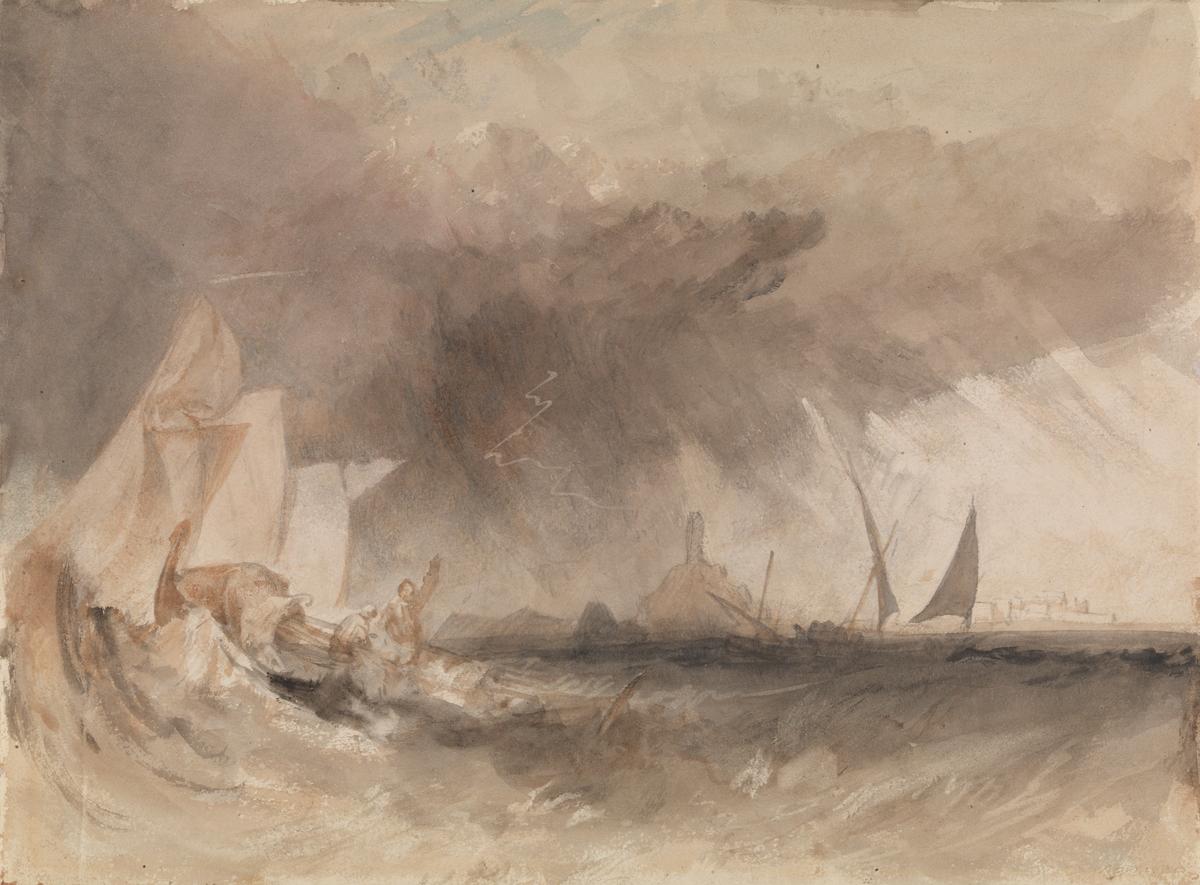Joseph Mallord William Turner The Felucca c.1824
Joseph Mallord William Turner,
The Felucca
c.1824
Joseph Mallord William Turner 1775–1851
The Felucca circa 1824
D08175
Turner Bequest CXVIII U
Turner Bequest CXVIII U
Pencil and watercolour on off-white wove writing paper, 197 x 267 mm
Blind-stamped with Turner Bequest monogram bottom right
Blind-stamped with Turner Bequest monogram bottom right
Accepted by the nation as part of the Turner Bequest 1856
Exhibition history
1904
National Gallery, London, various dates to at least 1904 (519).
1921
The Liber Studiorum by Turner: Drawings, Etchings, and First State Mezzotint Engravings with Some Additional Engravers’ Proofs and 51 of the Original Copperplates, National Gallery, Millbank [Tate Gallery], London, November 1921–November 1922 (not in catalogue).
1922
Original Drawings, Etchings, Mezzotints, and Copperplates for the “Liber Studiorum” by J.M.W. Turner, R.A., Whitworth Institute Art Galleries, Manchester, December 1922–March 1923 (not in catalogue).
Engraved:
(see main catalogue entry)
(see main catalogue entry)
References
1904
E.T. Cook and Alexander Wedderburn eds., Library Edition: The Works of John Ruskin: Volume XIII: Turner: The Harbours of England; Catalogues and Notes, London 1904, p.633 no.519.
1905
W[illiam] L[ionel] Wyllie, J.M.W. Turner, London 1905, p.62, reproduced opposite.
Liber Studiorum: J.M.W. Turner: Miniature Edition Containing Reproductions (I.) from First Published State of the Seventy-One Published Plates, and (II.) of the Original Drawings for, or Engraver’s Proofs of, All the Unpublished.
1906
W[illiam] G[eorge] Rawlinson, Turner’s Liber Studiorum, A Description and a Catalogue. Second Edition, Revised Throughout, London 1906, p.185 under no.82.
1911
Plates as the Artist Left Them, London and Glasgow 1911, reproduced p.100 no.82.
1909
A.J. Finberg, A Complete Inventory of the Drawings of the Turner Bequest, London 1909, vol.I, p.323, CXVIII U.
1921
Untitled typescript list of works relating to 1921 and 1922 Liber Studiorum exhibitions, [circa 1921], Tate exhibition files, Tate Archive TG 92/9/2, p.5.
1924
Alexander J. Finberg, The History of Turner’s Liber Studiorum with a New Catalogue Raisonné, London 1924, reproduced p.[328], p.329 under no.82.
1938
Martin Hardie, The Liber Studiorum Mezzotints of Sir Frank Short, R.A., P.R.E. after J.M.W. Turner, R.A. Catalogue & Introduction, London 1938, p.62, reproduced p.[99] pl.X (above).
1996
Gillian Forrester, Turner’s ‘Drawing Book’: The Liber Studiorum, exhibition catalogue, Tate Gallery, London 1996, pp.14, 15, 16, 146 no.82i, reproduced, p.152.
The title of this design for the unpublished Liber Studiorum plate refers to the type of boat seen in the distance to the right, with lateen sails (suspended from a yard at an angle from the mast) characteristic of the Mediterranean. Turner sketched numerous types of vessels with such sails on his first tour of Italy in 1819; there are examples in several sketchbooks: Venice to Ancona (Tate D14501, D14620; Turner Bequest CLXXVI 7a, 68a), Gandolfo to Naples (Tate D15631; Turner Bequest CLXXXIV 38a), Pompeii, Amalfi, &c. (Tate D15822, D15823; Turner Bequest CLXXXV 46a, 47) and Naples, Paestum and Rome (Tate D15944, D15949; Turner Bequest CLXXXVI 19, CLXXXVI 20 a); and a detailed study of a three-masted rig in the St Peter’s sketchbook (Tate D16255; Turner Bequest CLXXXVIII 55). The conjunction and details of the boats on the left may have developed from slight sketches in the Naples, Paestum and Rome book (Tate D15908; Turner Bequest CLXXXVI 1). There are also various sketches of Mediterranean coastal towers and lighthouses, such as those in the Gandolfo to Naples sketchbook (Tate D15688; Turner Bequest CLXXXIV 65) and the Naples, Paestum and Rome book (Tate D15919; Turner Bequest CLXXXVI 7)
As Gillian Forrester notes,1 the fluid technique and some use of colours beyond the overall ‘sepia’ tones of earlier Liber designs mark a transitional style moving towards the stormy chiaroscuro effects of the ‘Little Liber’ mezzotints of the mid-1820s (see general Liber introduction). Various points of comparison may be made with the Ports of England watercolours of about the same date: for example, the figures in the open boat recall those in Portsmouth (Tate D18152; Turner Bequest CCVIII S),2 while the overall composition has similarities to Deal (Walker Art Gallery, Liverpool).3
The mezzotint engraving (without preliminary etching) usually attributed to Henry Dawe, was among the unpublished Liber Studiorum prints (Rawlinson/Finberg nos.72–91;4 see also Tate D08170–D08174, D08176–D08178, D25451; Turner Bequest CCLXIII 328, Vaughan Bequest CXVIII P, Q, R, S, T, V, W, X; and Tate N02782, N03631). Tate does not hold any impressions.
Between 1920 and 1935, Frank Short etched and mezzotinted this composition,5 as one of his interpretations of the unpublished Liber plates (Tate does not hold an impression; see general Liber introduction).
Technical notes:
The sheet has faded somewhat. There is initial pencil sketching, overlaid with washes applied very wet, without detailed brushstrokes. The lightning is defined by stopping-out, showing that it was conceived early in the evolution of the image; there is also some stopping out in the waves, and other lights have been reserved or washed out, but not scratched out. The overall colour is brown, with traces of blue and warmer brown, made up of three brown pigments and a blue.1
The study for another unpublished Liber subject, Moonlight on the Medway (Tate D25451; Turner Bequest CCLXIII 328) uses a similar range of pigments, and both appear to be whole pages from the same sketchbook, which Forrester has suggested was the dispersed ‘Munro’ book,2 watermarked 1822 and probably in use at Farnley, Yorkshire, in 1824;3 the two designs could have been intended as a contrasting pair in the Liber’s ‘Marine’ category.4
For further discussion, see the entry for the sketches on the verso of the present sheet, apparently showing the landscape near Farnley (Tate D40073).
Matthew Imms
May 2006
How to cite
Matthew Imms, ‘The Felucca c.1824 by Joseph Mallord William Turner’, catalogue entry, May 2006, in David Blayney Brown (ed.), J.M.W. Turner: Sketchbooks, Drawings and Watercolours, Tate Research Publication, December 2012, https://www

